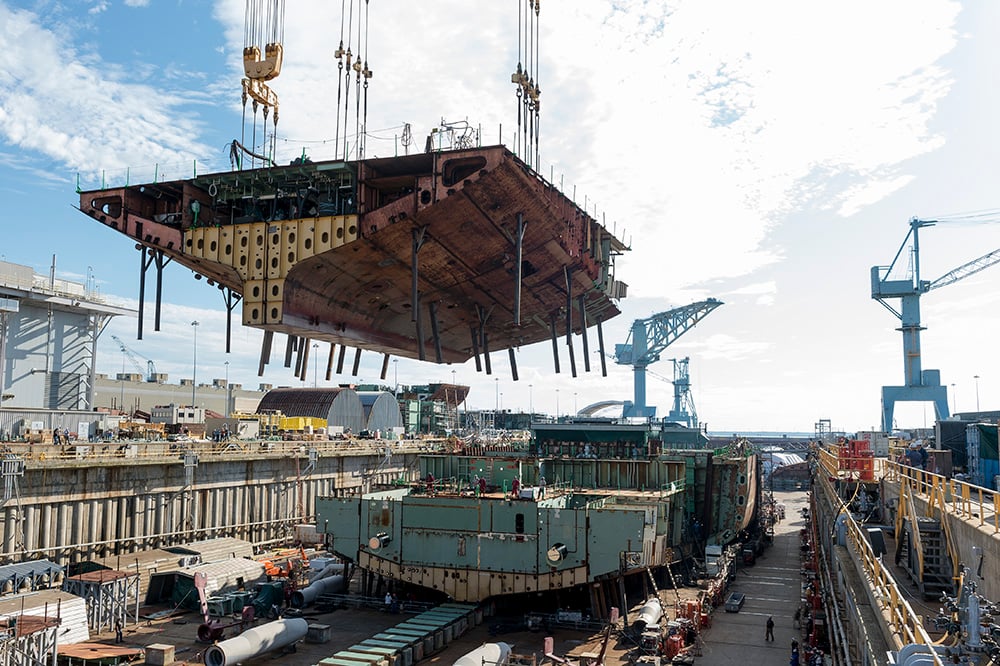
USS Kennedy under construction at Newport News Shipbuilding. (File)
WASHINGTON: Huntington Ingalls Industries is taking a big bet on unmanned systems.
That could probably be said of most defense industrial base companies right now. But what makes Ingalls, best known for building the Navy’s iconic aircraft carriers, different is its aggressive strides these past two years to carve out space in a crowded market. The impetus, a company executive told Breaking Defense, is simple: The Navy’s focus is changing and we’re going to follow.
“The Navy’s intent over the last 10 years — but has become much [clearer] in the last three to five years — is in Distributed Maritime Operations,” said Duane Fotheringham, president of the company’s unmanned systems group. “The precise numbers may vary but the intent is clear … The Navy will have unmanned [systems] being a significant part of its future fleet.”
As the Navy pushes forward with its strategy to disperse unmanned and autonomous ships across the battlespace, traditional defense companies that have spent years building the infrastructure and workforce to produce capital warships will likely find themselves competing against a vast market of smaller businesses. Those companies have spent the time and resources to perfect the technologies the Navy needs to operate its forthcoming fleet of unmanned vessels, and, in some cases, may have access to smaller shipyards capable of competing for production contracts.
Former Defense Secretary Mark Esper told Defense News in an interview last year he believes these smaller shipyards will be essential for the Navy to fulfill its vision laid out in its keystone concept, Distributed Maritime Operations.
“The United States must have an expanded and healthy industrial base with modern shipyards,” Esper said then. “I think we can actually expand the number of shipyards in the United States and highly skilled workers [as well] around the country to ensure adequate capacity.”
Strategic Acquisitions
HII in recent years has made a series of acquisitions and investments, as well as partnerships outside of its key shipyards in Virginia and Mississippi, to keep pace with this anticipated growth.
In fact, that strategy is how Fotheringham ended up at the shipbuilding company. After retiring from the Navy following nine years serving as a submarine officer, he made his way to Hydroid, a relatively small autonomous maritime vehicle design firm and subsidiary of the international aerospace giant Kongsberg. In March 2020, HII purchased Hydroid, of which Fotheringham was president. As a part of the acquisition, HII established its unmanned systems group by combining Hydroid’s assets with the company’s existing unmanned portfolio; Fotheringham was tapped to lead the new business unit.
Not long after that, HII purchased the autonomy business unit of Spatial Integrated Systems, a company the shipbuilder already had a relationship with through its ongoing work on the first stage of the Navy’s competition to build the Large Unmanned Surface Vessel. The company is also subcontracting for the Louisiana-based shipyard Metal Shark and its work with the Marine Corps’ Long-Range Unmanned Surface Vehicle. The bottom line: all these moves reach beyond capital warship production into the unmanned market.
Bringing smaller, and sometimes non-traditional, contractors into the defense industrial base has been a key focus for the Pentagon as a whole. It was the impetus to stand up entire agencies such as the Defense Innovation Unit. That strategy is being reflected by industry to shore up its own expertise: HII, not long after acquiring Hydroid, made an equity investment into Sea Machines, a company experienced with unmanned maritime technology, but largely focused on the commercial sector.
“The strategy of HII is … to be a key part of that future moving forward with the Navy, [to] invest in the platforms, invest in the autonomy architecture and invest in that future fleet structure to ensure that we’re part of that,” Fotheringham said.
But HII’s endeavors into unmanned are not just a bet against its industrial competitors. It’s a bet that the Navy can ultimately persuade Congress to fund its unmanned efforts at the pace and scale the Navy says it needs for the future fight. (Fotheringham estimated about 70% of his business portfolio relies on the US Navy, while the rest comes from foreign militaries, academia and the commercial sector.)
That has been a challenge for service officials who created a firestorm two years ago when they proposed retiring an aircraft carrier 25 years early in exchange for rapidly advancing a tranche of unmanned systems.
Outside observers at the time were skeptical whether the service truly wanted to retire a carrier or whether it was a Washington-style budget maneuver for additional research and development dollars. Regardless, it brought into view the skepticism many lawmakers had when presented with the choice of traditional warships or unmanned systems.
Asked about balancing investments and congressional skepticism, Fotheringham praised the Navy’s efforts to reduce risk through its unmanned campaign plan and framework, but added industry is often interested in seeing the Pentagon invest in new technologies more rapidly.
Congressional fights aside, HII’s play for a spot in the unmanned market has not stopped. By the end of the year, it expects to finish a new 155,000 square foot facility in Hampton, Va., focused on end-to-end design and production of unmanned systems.
The first major vehicle that will come from the company’s “Unmanned Center of Excellence” will be the Extra Large Unmanned Undersea Vehicle, a Navy program HII is partnered with Boeing to deliver.
Shipbuilder Austal USA names Michelle Kruger as new president
Kruger had been serving as interim president since former chief Rusty Murdaugh resigned last spring.



























